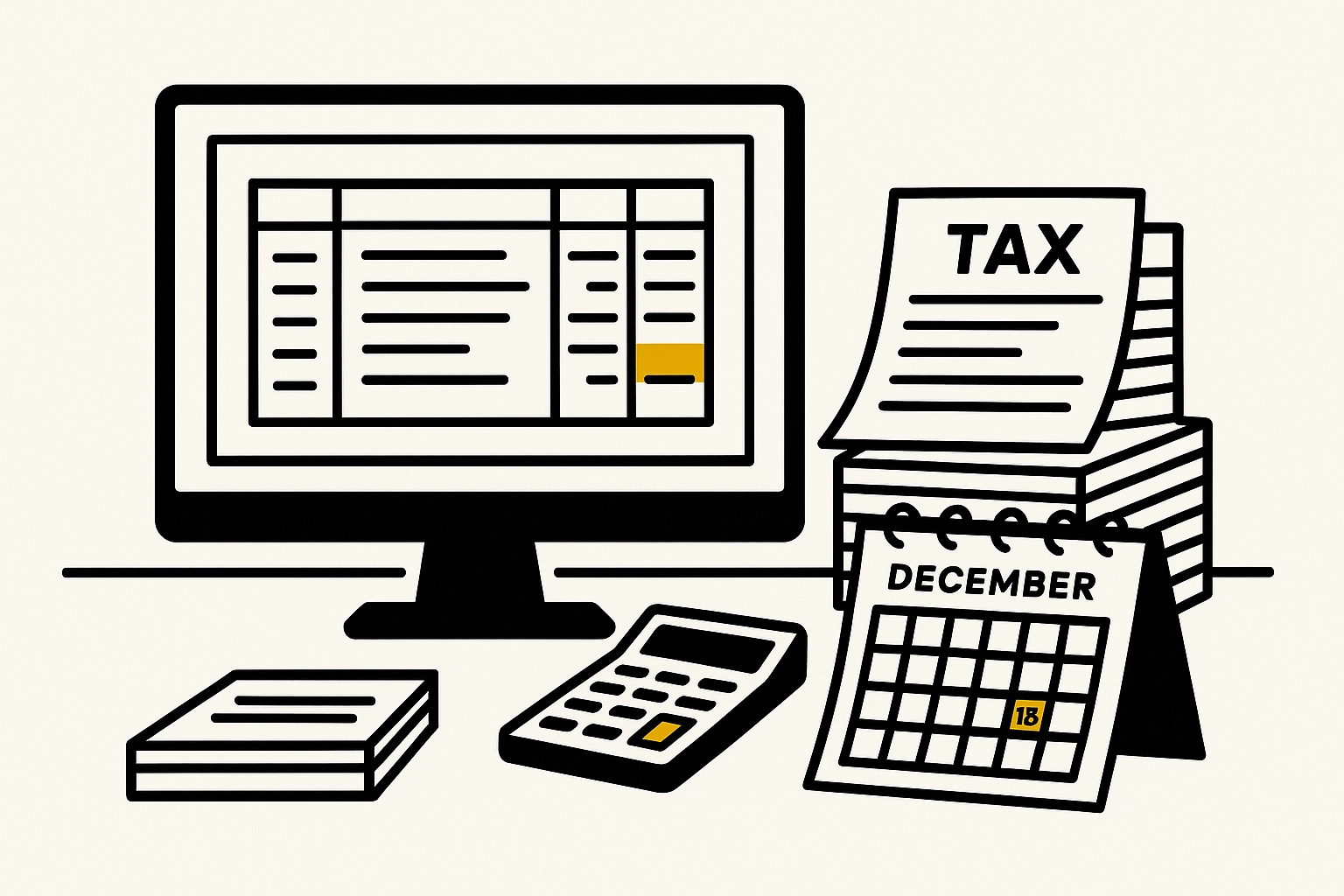End-of-Year HR Compliance: Key Deadlines and What Small Businesses Need to Know
- Justin Hall
- Sep 2
- 6 min read
As we approach the end of 2025, small business owners face a critical period that can make or break their HR compliance for the year ahead. The final quarter isn't just about holiday parties and year-end bonuses: it's when smart business owners buckle down to ensure their HR house is in order.
Missing key deadlines or overlooking compliance requirements can result in hefty fines, legal headaches, and damaged employee relationships that carry into the new year. But here's the good news: with proper planning and attention to detail, you can navigate this period successfully and set your business up for a compliant and prosperous 2026.
The High-Stakes World of Year-End HR Deadlines
Payroll and Tax Document Finalization
Your most time-sensitive task right now is finalizing all payroll and tax documents. This isn't just busy work: it's the foundation for accurate W-2 and 1099 form generation that the IRS demands by specific deadlines.
Start by ensuring all wages, bonuses, commissions, and other compensation for 2025 are accurately calculated and recorded. This includes those end-of-year bonuses you might be planning, holiday pay, and any final commission payments. Every dollar needs to be accounted for before December 31st.

The IRS doesn't mess around with these deadlines. W-2 forms must be provided to employees by January 31, 2026, and filed with the Social Security Administration by the same date. For 1099 forms, you have until January 31st to provide copies to contractors and file with the IRS. Missing these deadlines can result in penalties ranging from $50 to $280 per form, depending on how late you are.
Employee Information Verification
December is your last chance to clean up employee records before the year closes. Inaccurate employee information can create a domino effect of compliance issues that follow you into 2026.
Review and update current addresses, phone numbers, emergency contacts, job titles, and employment statuses. Pay special attention to employees who may have moved, gotten married, or changed their emergency contacts throughout the year. These seemingly small details become major problems when you're trying to mail W-2s to incorrect addresses or need to reach someone in an emergency.
Don't forget about benefits elections and life changes. Employees who experienced qualifying life events throughout 2025 may have made changes to their health insurance, retirement contributions, or other benefits that need to be properly documented.
Essential Compliance Areas That Demand Your Attention
Documentation and Record-Keeping
Your employee records are the backbone of HR compliance, and year-end is the perfect time to audit what you have. You need comprehensive records for each employee including personal information, work hours, wages, benefits, performance reviews, disciplinary actions, and training records.
Form I-9 documents deserve special attention. These should be stored securely and separately from other personnel files. If you haven't been keeping up with I-9 compliance throughout the year, now is the time to get current. Remember, these forms must be kept for three years after the date of hire or one year after employment ends, whichever is longer.

Consider implementing a digital storage system if you haven't already. Paper records are vulnerable to damage, loss, and difficulty in retrieval during audits. A secure digital system not only protects your records but makes compliance audits much more manageable.
Employment Classification Review
One of the most overlooked but critical year-end tasks is reviewing employee classifications. Are your exempt employees truly exempt under the Fair Labor Standards Act (FLSA)? Have job responsibilities changed throughout the year that might affect classification?
This review is crucial because misclassification can result in back wages, overtime payments, penalties, and legal fees that can devastate a small business. Document your rationale for each employee's exempt or non-exempt status. This documentation becomes invaluable during audits or legal challenges.
Pay particular attention to any employees whose roles have evolved significantly during 2025. That coordinator who started handling more managerial responsibilities might now qualify for exempt status, while that supervisor whose team was downsized might no longer meet exemption criteria.
Benefits Administration and ACA Compliance
If you have 50 or more full-time equivalent employees, you're subject to the Affordable Care Act's employer mandate. Year-end is when you need to prepare Forms 1094-C and 1095-C, which report whether you offered minimum essential coverage to your employees.
Even if you're not subject to the ACA mandate, review your benefits offerings and ensure all required notices have been provided to employees. This includes COBRA notices, Summary Plan Descriptions, and any required disclosures about plan changes for 2026.

Policy Updates and Training Requirements
Employee Handbook and Policy Review
Your employee handbook isn't a "set it and forget it" document. Laws change, your business evolves, and policies need to reflect current reality. Use year-end as an opportunity to review and update your handbook comprehensively.
Focus on anti-discrimination and harassment policies, which should be current with both federal and state requirements. Many states have updated their harassment prevention training requirements in recent years, so ensure your policies and training programs meet current standards.
Don't overlook newer requirements like pregnancy accommodation policies, which many states now require, or updated social media policies that reflect current technology use patterns.
Training Documentation
Compliance training isn't just about conducting the sessions: it's about documenting that they occurred. Review your training records to ensure you have proper documentation for all required training programs, including dates, participants, and content covered.
Required training often includes workplace safety, harassment prevention, diversity and inclusion, and data security. Some industries have additional requirements for specific training programs that must be completed annually.
Preparing for 2026: Your Compliance Roadmap
Building Your HR Compliance Calendar
Creating an HR compliance calendar for 2026 is one of the most valuable investments you can make in your business's future. This calendar should include all federal, state, and local compliance deadlines that affect your business.
Key dates to include are tax filing deadlines, required report due dates, training renewal requirements, and policy review deadlines. Don't forget industry-specific requirements that might apply to your business.

Consider using digital calendar tools that can send automatic reminders well in advance of each deadline. This proactive approach helps you avoid the scramble that comes with last-minute compliance efforts.
Legal Framework Considerations for 2026
As you plan for 2026, consider the full range of employment laws that affect your business. The Fair Labor Standards Act (FLSA) governs wage and hour requirements, while the Americans with Disabilities Act (ADA) affects your hiring practices and workplace accommodations.
The Family and Medical Leave Act (FMLA) applies once you reach 50 employees, and the Occupational Safety and Health Act (OSHA) affects businesses of all sizes. Understanding which laws apply to your business based on your size, location, and industry helps you prioritize your compliance efforts.
Technology and Systems Updates
Consider whether your current HR systems will meet your needs in 2026. Are you still managing employee records in spreadsheets? Is your timekeeping system generating the detailed records you need for compliance? Year-end is the perfect time to evaluate and upgrade your HR technology stack.
Modern HR Information Systems (HRIS) can automate many compliance tasks, from tracking training completion to generating required reports. While the upfront investment might seem significant, the time savings and reduced compliance risk often justify the cost.
Taking Action: Your Next Steps
Year-end HR compliance doesn't have to be overwhelming, but it does require systematic attention to detail. Start with your most time-sensitive tasks: payroll finalization and tax document preparation: then work through your compliance checklist methodically.
Remember that compliance is an ongoing process, not a year-end sprint. The systems and processes you put in place now will serve you throughout 2026 and beyond. Consider partnering with HR professionals who can help you navigate complex compliance requirements and provide ongoing support throughout the year.
The investment you make in proper HR compliance pays dividends in reduced legal risk, improved employee satisfaction, and the peace of mind that comes from knowing your business is operating on solid ground. Don't let year-end deadlines catch you off guard: take action now to ensure your business enters 2026 fully compliant and ready for growth.
For businesses that need expert guidance navigating these complex requirements, professional HR consulting can provide the expertise and support necessary to maintain compliance while focusing on business growth. Learn more about our comprehensive HR solutions and how we can help your business stay compliant year-round.
Comments